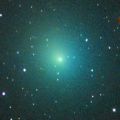
|
It became so bright as 4.7 mag, and so large as 20 arcmin in June (June 12, Marco Goiato). However, it will be getting fainter gradually after this. In the Northern Hemisphere, it will appear again in the morning sky at 5.5 mag in early July, then it keeps observable for a long time. In the Southern Hemipsphere, it keeps observable all the period until the comet fades out.
Date(TT) R.A. (2000) Decl. Delta r Elong. m1 Best Time(A, h)
June 28 4 0.52 -4 7.7 0.265 0.852 45 4.8 5:38 (255, 27)
July 5 3 30.96 2 22.4 0.314 0.870 54 5.3 5:38 (238, 34)
|

|
Great outburst occured on Oct. 24, and it bacame a naked eye comet of 2 mag. It kept so bright as 5.5 mag still on Apr. 30 (Carlos Labordena), but it was extremely faint and difficult to see. The size was so large, the diameter was larger than 60 arcmin. It is not observable in this summer. But it will become observable in good condition in autumn again. The extremely faint large diffuse object may be detected with a best sky condition, around 5-6 mag with a diameter of 1 or 2 degrees.
Date(TT) R.A. (2000) Decl. Delta r Elong. m1 Best Time(A, h)
June 28 6 56.81 33 11.6 4.469 3.479 11 6.0 18:28 (118,-18)
July 5 7 7.38 32 46.5 4.503 3.507 10 6.0 18:31 (116,-21)
|

|
It is already very bright as 9.5 mag (June 29, Marco Goiato). Brightening well, and expected to be 6 mag in September. However, it keeps moving in the southern sky, and it is unobservable for a while in the Northern Hemisphere. It will appear in the evening sky at 6 mag in late September, but it keeps locating in the evening low sky until the end of 2008 when it fades out down to 9 mag. Then it turns to appear in the morning sky, and it keeps observable in the northern sky after that while fading gradually. In the Southern Hemisphere, it keeps observable until late October.
Date(TT) R.A. (2000) Decl. Delta r Elong. m1 Best Time(A, h)
June 28 6 48.63 -36 42.8 2.087 1.811 60 9.2 18:28 ( 58, 19)
July 5 7 6.23 -37 59.9 1.982 1.731 60 8.9 18:31 ( 55, 18)
|
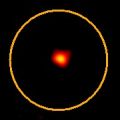
|
Now it is so bright as 10.1 mag (June 27, Marco Goiato). It will be bright at 10 mag in July. However, it keeps locating extremely low for a while in the Northern Hemisphere. It will be getting higher gradually after late July, then it keeps observable while fading gradually. It will be visible visually until September.
Date(TT) R.A. (2000) Decl. Delta r Elong. m1 Best Time(A, h)
June 28 3 26.20 18 19.4 1.433 0.973 42 10.2 5:38 (231, 18)
July 5 3 56.61 20 44.9 1.474 0.987 41 10.0 5:38 (229, 16)
|
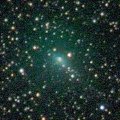
|
It brightened rapidly, and now it is so bright as 10.3 mag (June 27, Juan Jose Gonzalez). In the Northern Hemisphere, it keeps observable until 2009 spring when the comet becomes faint. It will move near by the Northern Pole from summer to autumn, and will be observable all night. It keeps bright at 10 mag until August, then it will be visible visually until around October. In the Southern Hemisphere, it will never be observable again.
Date(TT) R.A. (2000) Decl. Delta r Elong. m1 Best Time(A, h)
June 28 21 57.18 59 31.4 1.464 1.736 86 10.2 3:32 (180, -4)
July 5 22 1.07 65 9.2 1.482 1.728 85 10.2 3:08 (180,-10)
|

|
It will reach to 11 mag in summer. It must have already brightened up to 11 mag, but the comet was not observed recently. The condition in this apparition is bad. In the Southern Hemisphere, it keeps extremely low, or under the horizon, so it will not be observable. In the Northern Hemisphere, it is not observable until August when it appears in the morning sky at 11 mag. After August, it keeps observable and fading in the morning sky.
Date(TT) R.A. (2000) Decl. Delta r Elong. m1 Best Time(A, h)
June 28 4 44.13 14 22.5 2.221 1.384 26 11.3 5:38 (247, 7)
July 5 5 6.46 16 33.8 2.198 1.370 26 11.2 5:38 (244, 7)
|
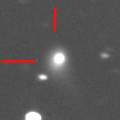
|
Now it is bright as 11.9 mag (June 28, Juan Jose Gonzalez), brightening almost as expected. It will reach to 10.5 mag and will be observable in good condition in 2008 autumn. It keeps observable, visible visually, brighter than 14 mag for one year until 2009 May.
Date(TT) R.A. (2000) Decl. Delta r Elong. m1 Best Time(A, h)
June 28 2 9.74 38 10.9 3.003 2.584 56 11.5 5:38 (205, 11)
July 5 2 24.47 40 10.3 2.925 2.559 59 11.4 5:38 (202, 10)
|

|
It reached to 10.9 mag in May (May 11, Marco Goiato). Now it is fading slowly. In the Southern Hemisphere, it keeps observable until late August when it fades down to 12 mag. In the Northern Hemisphere, it will be unobservable soon. But it will appear in the morning sky again at 13 mag at the end of 2008, then it keeps bright and observable for a while.
Date(TT) R.A. (2000) Decl. Delta r Elong. m1 Best Time(A, h)
June 28 10 57.57 -8 47.2 2.883 2.764 73 11.5 18:28 (127, 52)
July 5 11 8.05 -7 36.8 2.972 2.764 68 11.6 18:31 (123, 48)
|

|
Now it is bright as 11.3 mag (June 27, Juan Jose Gonzalez). It keeps bright at 12 mag for a long time from 2008 spring to 2009 spring. However, it is only observable until August in the Northern Hemisphere because the comet moves southwards. It keeps observable for a long time in the Southern Hemisphere.
Date(TT) R.A. (2000) Decl. Delta r Elong. m1 Best Time(A, h)
June 28 16 33.96 -25 18.1 2.085 3.031 153 11.9 22:05 (180, 80)
July 5 16 19.53 -27 12.9 2.114 2.997 144 11.9 21:23 (180, 82)
|
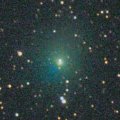
|
It reached up to 9.5 mag on Mar. 29 (Maik Meyer). Now it is fading slowly. It faded down to 10.7 mag on May 11 (Marco Goiato), and it was a diffuse object with a weak condensation. In the Northern Hemisphere, it will never be observable again. In the Southern Hemisphere, it keeps observable until it fades out. No observations have been reported recently, and the current brightness is uncertain.
Date(TT) R.A. (2000) Decl. Delta r Elong. m1 Best Time(A, h)
June 28 8 20.42 -17 49.4 2.130 1.658 49 12.1 18:28 ( 87, 28)
July 5 8 34.86 -20 56.0 2.197 1.724 49 12.4 18:31 ( 81, 26)
|

|
It had been brightening as expected, although looking very small, until mid June, and it brightened up to 13.7 mag on June 14 (David Seargent). However, now it is so bright as 10.6 mag (June 28, Juan Jose Gonzalez). The comet suddenly brightened very much. It is expected to reach to 6 mag in 2009 February. But it may become much brighter than this ephemeris. It keeps observable until October.
Date(TT) R.A. (2000) Decl. Delta r Elong. m1 Best Time(A, h)
June 28 21 6.34 -15 10.7 2.109 2.977 142 12.9 2:42 (180, 70)
July 5 20 49.55 -16 14.3 1.959 2.901 152 12.6 1:58 (180, 71)
|
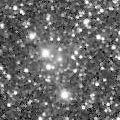
|
Brightening rapidly. It is already bright as 14.0 mag (June 27, Michael Jager). It will be brightening rapidly after this. It will reach up to 9 mag and keep bright for a long time from summer to autumn. In the Northern Hemisphere, it becomes low in the south at brightest, but it keeps observable until it fades out.
Date(TT) R.A. (2000) Decl. Delta r Elong. m1 Best Time(A, h)
June 28 19 28.68 13 30.1 0.526 1.461 140 14.1 1:04 (180, 41)
July 5 19 33.12 11 56.4 0.479 1.433 144 13.4 0:41 (180, 43)
|
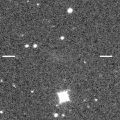
|
It approached to the sun down to 0.45 A.U. on June 19. In the Northern Hemisphere, it was observable in the morning low sky from mid May to mid June. Extremely diffuse. Michael Jager reported it was 13.5-14.0 mag on May 31, but it was not detected, fainter than 13 mag, on June 3 and 10. So maybe it disappeared before the perihelion passage. However, Mieczyslaw L. Paradowski and Juan Jose Gonzalez reported it was very bright around 11 mag visually in early June.
Date(TT) R.A. (2000) Decl. Delta r Elong. m1 Best Time(A, h)
June 28 6 44.09 38 59.7 1.387 0.497 16 13.7 18:28 (122,-23)
July 5 7 9.67 32 35.3 1.565 0.592 10 14.7 18:31 (116,-21)
|

|
It was 15 mag on Jan. 14 (Michael Mattiazzo), brightening as expected. It will reach to 13.5 mag in the southern sky in spring and summer. In the Southern Hemisphere, it keeps observable for a long time after this. But in the Northern Hemisphere, it is not observable now. But it will appear in the morning sky at 15 mag in November, then it keeps observable while the comet will be fading slowly.
Date(TT) R.A. (2000) Decl. Delta r Elong. m1 Best Time(A, h)
June 28 7 18.69 -38 2.1 2.813 2.510 62 13.7 18:28 ( 60, 25)
July 5 7 40.77 -37 9.3 2.853 2.519 60 13.8 18:31 ( 60, 23)
|

|
Now it is bright as 12.7 mag (Apr. 12, Marco Goiato). In the Northern Hemisphere, it will be getting lower gradually in the evening sky, and will be unobservable in late July. Then the comet will go southwards, so it will never be observable again in the Northern Hemisphere. In the Southern Hemisphere, it keeps observable in good condition for a long time until autumn.
Date(TT) R.A. (2000) Decl. Delta r Elong. m1 Best Time(A, h)
June 28 12 10.89 -7 16.1 2.867 3.023 88 13.8 18:28 (157, 61)
July 5 12 15.89 -8 33.4 2.945 3.011 83 13.8 18:31 (145, 59)
|

|
Now it is not observable. In the last season, it became so bright as 10 mag in 2008 January. It will appear in the morning sky in late August.
Date(TT) R.A. (2000) Decl. Delta r Elong. m1 Best Time(A, h)
June 28 6 59.04 26 36.7 7.043 6.037 7 14.1 18:28 (113,-14)
July 5 7 5.02 26 24.4 7.053 6.039 4 14.1 18:31 (110,-19)
|
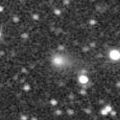
|
It was bright as 12.7 mag on May 12 (Juan Jose Gonzalez), and strongly condensed. However, it has been getting diffuse and fading rapidly after that. Now it is 14.5 mag (June 27, Michael Jager). A temporary outburst seems to be ending. It keeps observable in good condition until autumn. But it is moving southwards gradually, and the altitude will be getting somewhat lower in the Northern Hemisphere. It may fade out very rapidly after this.
Date(TT) R.A. (2000) Decl. Delta r Elong. m1 Best Time(A, h)
June 28 16 30.74 -16 26.9 1.544 2.485 151 14.2 22:02 (180, 72)
July 5 16 27.92 -17 2.1 1.597 2.495 144 14.3 21:32 (180, 72)
|
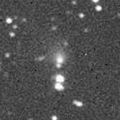
|
It is already bright as 14.7 mag and visible visually (Mar. 5, Seiichi Yoshida). It is expected to reach to 11 mag in 2009 summer. Because it moves in the northern sky, it keeps observable until it becomes brightest in the Northern Hemisphere. Although it had been low for a while, it will be getting higher gradually after this.
Date(TT) R.A. (2000) Decl. Delta r Elong. m1 Best Time(A, h)
June 28 3 58.96 60 2.7 5.344 4.681 45 14.5 5:38 (207,-17)
July 5 4 2.33 60 54.5 5.246 4.636 48 14.5 5:38 (204,-15)
|
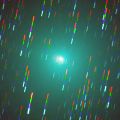
|
It passed near by Earth in early January, and it became a bright large object at 5.4 mag (Jan. 3, Seiichi Yoshida). It was visible with naked eyes. Now it is fading rapidly. It had faded down to 11.3 mag on May 10 (Marco Goiato). It has already moved away towards the southern sky, and it is no longer observable in the Northern Hemisphere. In the Southern Hemisphere, it keeps observable until it fades out.
Date(TT) R.A. (2000) Decl. Delta r Elong. m1 Best Time(A, h)
June 28 11 36.28 -53 31.7 1.873 2.298 101 14.6 18:28 ( 31, 67)
July 5 11 58.65 -51 46.9 1.983 2.368 99 15.0 18:31 ( 36, 67)
|

|
Now it is 13.5 mag (May 8, Marco Goiato), bright and visible visually. It keeps observable visually at 13 mag at high location for a while.
Date(TT) R.A. (2000) Decl. Delta r Elong. m1 Best Time(A, h)
June 28 15 24.00 22 57.7 5.205 5.719 115 14.8 20:56 (180, 32)
July 5 15 17.62 22 54.1 5.306 5.729 109 14.8 20:22 (180, 32)
|

|
Now it is 16.1 mag, brightening well as expected (Mar. 30, S. G. McAndrew). It is expected to brighten up to 10 mag from late 2009 to early 2010. Because the comet moves in the southern sky for a long time, it keeps impossible or very hard to observe in the Northern Hemisphere until 2009 September. But after 2009 October, it is observable at 10 mag for a while in good condition. In the Southern Hemisphere, it keeps observable for a long time while brightening until 2009 June when it brightens to 11 mag. But it becomes unobservable around and after the brightest time.
Date(TT) R.A. (2000) Decl. Delta r Elong. m1 Best Time(A, h)
June 28 4 43.13 -36 39.3 5.629 5.278 64 15.3 5:38 (294, 35)
July 5 4 51.15 -36 50.4 5.541 5.222 66 15.2 5:38 (292, 38)
|
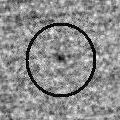
|
The nuclear magnitude was reported as 17.5 mag on June 7, but the total brightness will be already bright as 16 mag. It will be getting higher gradually after this. It will be observable at 15 mag in good condition until November.
Date(TT) R.A. (2000) Decl. Delta r Elong. m1 Best Time(A, h)
June 28 1 33.54 8 8.3 2.265 2.176 71 15.4 5:38 (211, 42)
July 5 1 46.11 9 1.0 2.183 2.163 75 15.3 5:38 (206, 43)
|

|
Not observed in this return yet. But appearing in the morning sky. Now it must be brightest. Yasukazu Ikari reported it was fainter than 15 mag on June 16. It will be getting higher gradually after this. It will be observable in good condition until autumn when it becomes fainter than 18 mag.
Date(TT) R.A. (2000) Decl. Delta r Elong. m1 Best Time(A, h)
June 28 2 2.87 7 10.9 1.835 1.690 65 15.8 5:38 (220, 39)
July 5 2 19.85 8 34.9 1.794 1.695 67 15.7 5:38 (216, 39)
|

|
Now it is 15.3 mag (May 15, Ken-ichi Kadota). It keeps observable in good condition after this in the Northern Hemisphere. It will be fading gradually, and will be fainter than 18 mag in November.
Date(TT) R.A. (2000) Decl. Delta r Elong. m1 Best Time(A, h)
June 28 23 22.68 34 39.6 1.976 2.213 89 15.9 4:57 (180, 20)
July 5 23 25.00 38 12.7 1.961 2.249 92 16.0 4:32 (180, 17)
|

|
Now it is brightest at 16 mag. Moving northwards very fast, and it will be observable in good condition in the Northern Hemisphere after this. It keeps 16 mag until mid July. But it will be fainter than 18 mag in August.
Date(TT) R.A. (2000) Decl. Delta r Elong. m1 Best Time(A, h)
June 28 20 3.03 -31 26.8 1.254 2.228 157 16.0 1:40 (180, 87)
July 5 19 32.98 -27 51.5 1.259 2.268 170 16.1 0:42 (180, 83)
|
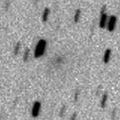
|
Now it is 16.8 mag (June 9, Yasukazu Ikari). It reaches to 16 mag from May to July, and observable in good condition.
Date(TT) R.A. (2000) Decl. Delta r Elong. m1 Best Time(A, h)
June 28 14 25.37 56 15.3 1.575 1.806 85 16.1 19:57 (180, -1)
July 5 14 23.89 49 7.6 1.588 1.824 85 16.1 19:29 (180, 6)
|

|
Now it is 16.6 mag (June 1, Gustavo Muler). It will be 15.5 mag from July to October. It locates somewhat low in the Northern Hemisphere, but it keeps observable around 16 mag until winter.
Date(TT) R.A. (2000) Decl. Delta r Elong. m1 Best Time(A, h)
June 28 21 45.29 -28 22.0 2.248 3.059 135 16.3 3:20 (180, 83)
July 5 21 43.69 -28 36.7 2.176 3.044 142 16.1 2:51 (180, 84)
|

|
Now it is 17.3 mag (May 25, Ken-ichi Kadota). It keeps observable while the comet will be brightening gradually after this. It will reach up to 14.5 mag in autumn. However, then it locates low in the evening sky, and it will be unobservable soon in December.
Date(TT) R.A. (2000) Decl. Delta r Elong. m1 Best Time(A, h)
June 28 15 26.85 -3 13.3 1.876 2.663 131 16.4 20:59 (180, 58)
July 5 15 24.66 -3 23.3 1.899 2.618 125 16.3 20:29 (180, 58)
|

|
An outburst occured in late May, and it brightened up to 14.6 mag (May 23, Gustavo Muler). However, it faded down to the original brightness in late May. Now it is 17.2 mag (May 31, Katsumi Yoshimoto). It will reach to 14 mag in autumn, but it locates extremely low in the Northern Hemisphere. However, it keeps higher than 30 degree even in the Northern Hemisphere until August.
Date(TT) R.A. (2000) Decl. Delta r Elong. m1 Best Time(A, h)
June 28 11 28.92 25 29.3 1.739 1.643 67 16.7 18:28 (158, 26)
July 5 11 41.49 23 1.6 1.738 1.595 64 16.6 18:31 (153, 27)
|
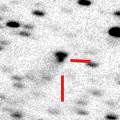
|
It was observed at 16.5-17 mag in 2006 and 2007. Because it is a very distant comet, it is observable at 17 mag still in 2008 in good condition.
Date(TT) R.A. (2000) Decl. Delta r Elong. m1 Best Time(A, h)
June 28 18 44.69 44 9.1 5.879 6.338 112 17.4 0:20 (180, 11)
July 5 18 35.79 44 31.7 5.897 6.356 112 17.4 23:39 (180, 10)
|

|
It was 18-19 mag in June. It will be brightening gradually after this, and reach to 12-13 mag in 2009 winter and spring. In the Northern Hemisphere, it keeps observable for a long time until 2009 May.
Date(TT) R.A. (2000) Decl. Delta r Elong. m1 Best Time(A, h)
June 28 21 57.08 -22 44.0 2.009 2.796 132 17.6 3:32 (180, 78)
July 5 21 56.15 -23 16.9 1.897 2.747 139 17.4 3:04 (180, 78)
|

|
New comet. It had been observable at 17 mag in the northern sky in spring, but it has not been discovered. Extremely diffuse. It will be fainter than 18 mag soon.
Date(TT) R.A. (2000) Decl. Delta r Elong. m1 Best Time(A, h)
June 28 13 19.35 46 23.8 2.068 2.166 81 17.4 18:51 (180, 9)
July 5 13 12.84 41 5.3 2.172 2.198 77 17.6 18:31 (177, 14)
|

|
It will brighten up to 12 mag in 2012. It is faint still in 2008, but observable at 17 mag in good condition.
Date(TT) R.A. (2000) Decl. Delta r Elong. m1 Best Time(A, h)
June 28 23 35.03 8 34.2 10.674 10.874 98 17.5 5:10 (180, 46)
July 5 23 33.65 8 35.0 10.519 10.837 105 17.5 4:41 (180, 46)
|
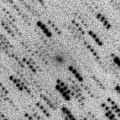
|
In April, it became so bright as 11.3 mag (Apr. 12, Marco Goiato). But CCD observers reported it was faint as 15 mag. It was difficult to see because extremely diffuse. In the Northern Hemisphere, it had been low until March, but now it locates high. But it is already fading. It has already faded down to 16.8 mag (June 13, Ken-ichi Kadota).
Date(TT) R.A. (2000) Decl. Delta r Elong. m1 Best Time(A, h)
June 28 20 20.82 28 41.4 0.836 1.618 121 17.5 1:56 (180, 26)
July 5 20 13.02 28 38.7 0.864 1.673 125 17.7 1:21 (180, 26)
|

|
The condition in the Northern Hemisphere was very good in first half of May, and it was observed at 16 mag. It will approach to the sun down to 0.1 A.U. on June 17. If it shows a cometary activity, it may become much brighter than this ephemeris. However, it is not observable on the earth.
Date(TT) R.A. (2000) Decl. Delta r Elong. m1 Best Time(A, h)
June 28 7 28.26 22 44.0 1.363 0.446 13 17.7 18:28 (114, -6)
July 5 8 19.99 21 28.4 1.508 0.641 19 18.7 18:31 (115, -1)
|
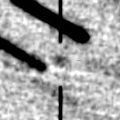
|
New comet. It keeps observable at 17-18 mag in good condition until November.
Date(TT) R.A. (2000) Decl. Delta r Elong. m1 Best Time(A, h)
June 28 0 3.34 25 28.0 2.398 2.529 85 17.9 5:38 (180, 30)
July 5 0 12.83 26 34.5 2.321 2.521 89 17.8 5:20 (180, 28)
|

|
No observations have been succeeded since 2007 July. It was predicted to be so bright as 14 mag now. But actually, it is fainter than 19 mag and not detectable (June 1, Gustavo Muler). It will locate in good condition from spring to summer. But it seems to have already disappeared.
Date(TT) R.A. (2000) Decl. Delta r Elong. m1 Best Time(A, h)
June 28 22 24.14 9 45.9 1.589 2.203 113 20.2 3:59 (180, 45)
July 5 22 26.61 11 23.9 1.563 2.234 118 20.2 3:34 (180, 44)
|

|
It is expected to reach up to 7 mag in winter, and will be observable in good condition. However, this comet has not been observed since 1986. It was not detected, fainter than 18 mag, on May 31 (Katsumi Yoshimoto). It is predicted to be so faint as 21 mag still now. But it will brighten very rapidly near by the perihelion. It will be 18 mag in August. The condition of this apparition is good. It keeps observable for a long time until 2009 early summer both in the Northern Hemisphere and Southern Hemisphere.
Date(TT) R.A. (2000) Decl. Delta r Elong. m1 Best Time(A, h)
June 28 20 47.48 -23 10.2 1.496 2.420 148 21.1 2:23 (180, 78)
July 5 20 43.97 -23 29.0 1.392 2.356 155 20.5 1:52 (180, 78)
|
|
![]()
 C/2006 OF2 ( Broughton )
C/2006 OF2 ( Broughton ) C/2006 Q1 ( McNaught )
C/2006 Q1 ( McNaught ) C/2007 G1 ( LINEAR )
C/2007 G1 ( LINEAR ) C/2008 C1 ( Chen-Gao )
C/2008 C1 ( Chen-Gao ) C/2007 N3 ( Lulin )
C/2007 N3 ( Lulin ) 6P/d'Arrest
6P/d'Arrest C/2008 J4 ( McNaught )
C/2008 J4 ( McNaught ) C/2006 U6 ( Spacewatch )
C/2006 U6 ( Spacewatch ) C/2007 B2 ( Skiff )
C/2007 B2 ( Skiff ) 29P/Schwassmann-Wachmann 1
29P/Schwassmann-Wachmann 1 P/2008 J2 ( Beshore )
P/2008 J2 ( Beshore ) C/2006 W3 ( Christensen )
C/2006 W3 ( Christensen ) 8P/Tuttle
8P/Tuttle C/2005 L3 ( McNaught )
C/2005 L3 ( McNaught ) C/2007 Q3 ( Siding Spring )
C/2007 Q3 ( Siding Spring ) 61P/Shajn-Schaldach
61P/Shajn-Schaldach 51P/Harrington
51P/Harrington C/2008 J6 ( Hill )
C/2008 J6 ( Hill ) C/2008 J5 ( Garradd )
C/2008 J5 ( Garradd ) C/2007 W3 ( LINEAR )
C/2007 W3 ( LINEAR ) 47P/Ashbrook-Jackson
47P/Ashbrook-Jackson 68P/Klemola
68P/Klemola 7P/Pons-Winnecke
7P/Pons-Winnecke C/2005 S4 ( McNaught )
C/2005 S4 ( McNaught ) 67P/Churyumov-Gerasimenko
67P/Churyumov-Gerasimenko C/2008 L3 ( Hill )
C/2008 L3 ( Hill ) C/2006 S3 ( LONEOS )
C/2006 S3 ( LONEOS ) 26P/Grigg-Skjellerup
26P/Grigg-Skjellerup 2008 HW1
2008 HW1 C/2008 L2 ( Hill )
C/2008 L2 ( Hill ) C/2007 K3 ( Siding Spring )
C/2007 K3 ( Siding Spring ) 85P/Boethin
85P/Boethin![]()





























